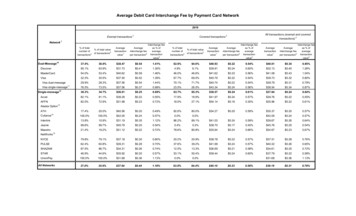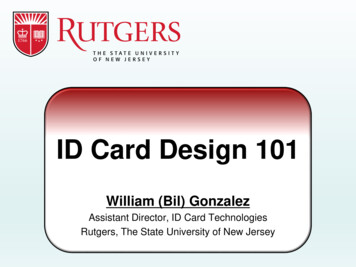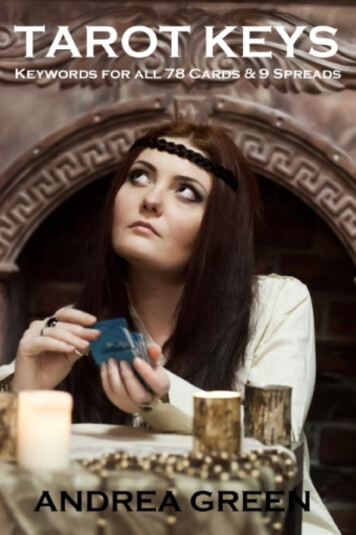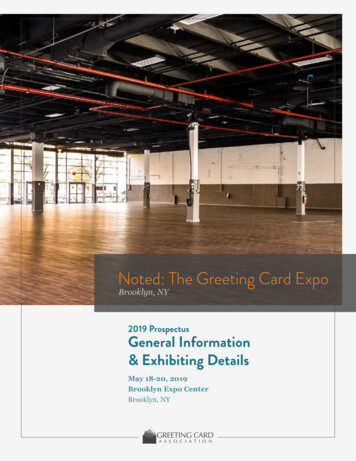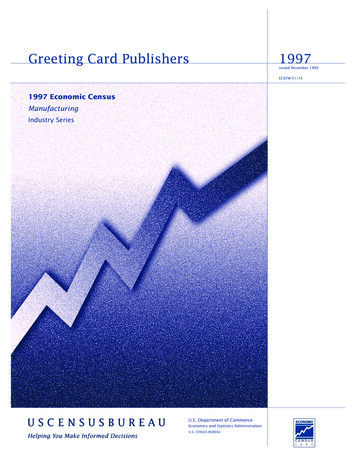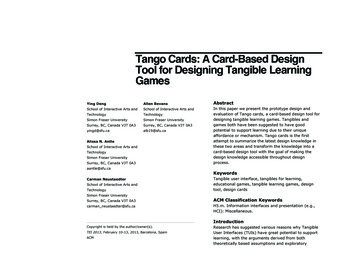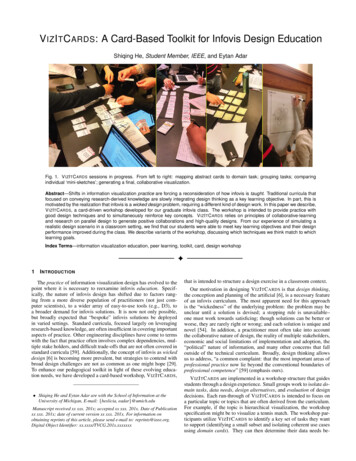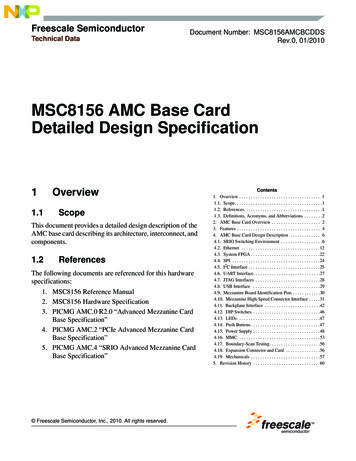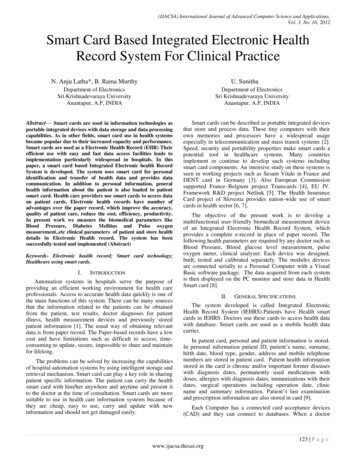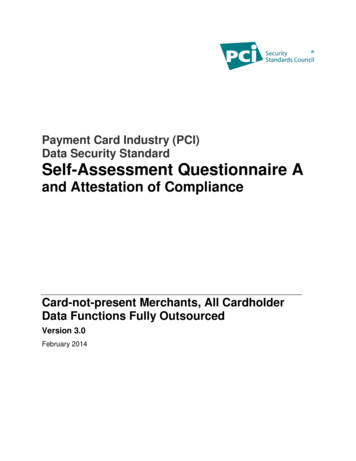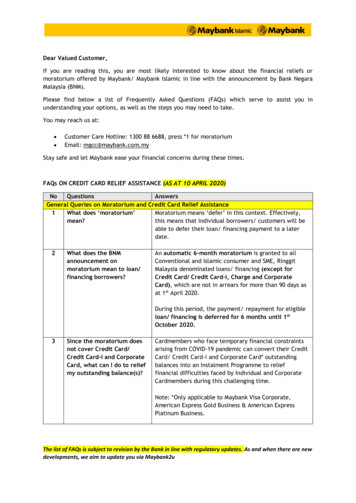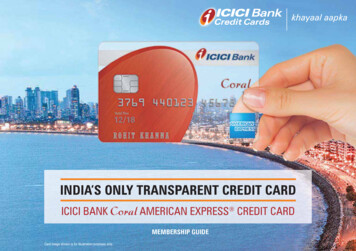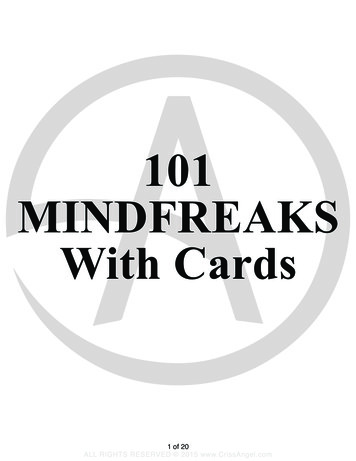
Transcription
101MINDFREAKSWith Cards1 of 20
101 MINDFREAKS WITH CARDSINTRODUCTIONCard magic is probably the most popular branch of magic in the world. In fact, some magiciansspecialize in performing this type of magic alone. This booklet has been designed to teach youmany of the basic principles associated with card magic. With a little practice and a deck ofcards, you’ll soon be destroying your audience with these MINDFREAKS. There are manyMINDFREAKS involving the discovery of cards selected by a spectator. These depend on avariety of factors to keep you one ahead of the spectators. Basically there are three ways todiscovering a spectator’s chosen card. You can “force” the card on the spectator. Using a forceyou can make them choose a particular card, then predict it, name it, or produce a duplicatefrom some place else. You can also merely “locate” the card by its placement in the pack or bylooking through the cards as you deal them. You can also “control” the chosen card, byshuffling, cutting or manipulating the cards in your favor. All three methods will be covered inthis book, as well as additional effects with a regular deck of cards. We will also go into specialgimmicks that can help you including, the “short card”, the “thick” card and the “crimped” card.SELF-WORKING CARD EFFECTSThere are many incredible card effects that work without any real skill on the magician’s part.Some effects are based on mathematic principles, others on special arrangements of cards.This first section will deal with easy self-working card effects. This will allow you to betterconcentrate on the presentation of the effects and become a better performer.One Card ReversalThe only set up you need is to turn over the bottom card of the pack so it is face up. Spreadthe cards and have a spectator select one. Make sure to keep the bottom face up card hidden.While they are looking at their card, square the deck up and turn it over. The deck will appearto be face down because the bottom card is facing down. Have their card inserted into thedeck and square the cards. Put the deck behind your back and flip the reversed card backover. Now spread the deck face up revealing one card face down - it is the selected card!Checker CardsTo prepare for this effect separate the cards into two piles of red and black. Assemble the pilesone on top of the other and you are ready to perform. Fan the faces towards you so you caneasily separate the cards into their respective piles. Place the piles face down on the table.Have a spectator select a card from each pile and replace it in the other. Place the pilestogether and square them up. To locate the selected cards, run through the deck and removethe red card from the black pile and vice versa. Be sure to keep the faces hidden from youraudience. When you are finished, shuffling the deck will destroy any evidence of a prearrangeddeck.2 of 20
Four to the TopRemove the four jacks from the deck and three different cards as well. Hold the different cardsface up in your hand, then lay the four jacks spread out on top keeping the three differentcards concealed. Show the four jacks, then square all the cards and place them face down ontop of the deck. Tell the story of four robbers robbing the bank. Slide the top card off the packand place it into the deck near the bottom, the cellar. The next one goes in a little higher, thefirst floor. The third jack above that, the second floor. The last one stays on top, the roof. Youhave now slid what appears to be three jacks into the deck, but in reality you only moved thethree different cards. Talk about the police arriving and the only way to escape was through theroof. Turn the top four cards over revealing the jacks.Disappearing CardIn this effect, the spectator’s selected card vanishes without a trace. This is easilyaccomplished by placing a small piece of double-sided tape on the top of the deck. Have aspectator select a card, then replace it on top of the deck. The card will stick to the tapecreating a double card. Cut the cards, then deal the cards face up on the table asking thespectator to stop you when he sees his card. When you reach the end of the deck, they willfind the selected card has vanished!FoundTo prepare for this effect, you will need two cards of the same color, but opposite suits, andtheir mates. For instance, a seven of clubs and a six of spades, then a six of clubs with aseven of spades. Place one card of one pair on the top and bottom of the deck. Place the othertwo cards on the table. Show the two cards on the table but don’t call attention to the suits,only the numbers and colors. Place each one in different places in the deck. Hold the deck inyour right hand with your thumb on top and fingers underneath. Snap your left hand fingersthen toss the deck from right hand to left hand, maintaining pressure on the top and bottomcards. If done correctly, all the cards should be released except the top and bottom cards(black six and seven). Turn the cards face up and show you have magically relocated the lostcards. The spectators will not realize they are two different cards. They will think they are thesame because they are the same color and number.Amazing Four AcesThe spectator selects a card and returns it to the deck. The cards are spread revealing a faceup card - it’s a five. He explains it is an indicator card and counts down five cards revealing thespectator’s selected card. The other four cards are turned over - they are the four aces! Toprepare for this effect, place a five face up on the bottom of the deck, followed by the four acesface down. Have a card selected and replaced on top of the deck. Cut the cards apparentlylosing their card in the deck. The action of cutting positions the bottom cards on top of theselected card. All you need to do is spread the cards revealing the five. Count down five cardsand turn over the fifth card revealing their selected card. Then, for the kicker, flip the four cardsin between them over revealing the four aces!Pocket AcesTo prepare for this effect you will secretly remove the four aces from the deck and place themin your pocket. Have a spectator shuffle the cards and return them to you. Place the cards inyour pocket beside the four aces. Then reach into your pocket and remove the aces one at atime. It will appear as if you magically plucked them from the deck one by one!3 of 20
Ten Card MysteryThis effect requires the spectator to do most of the work. Allow the spectator to shuffle thecards and remove ten cards. He is then to memorize any card and note its position from thetop of the deck. You take the cards and apparently cut them. In reality, you move five cardsfrom the top to the bottom of the deck. Give the cards back to the spectator and instruct themto move one card from top to bottom based on the position of his selected card. For instance, ifhis selected card was fifth from the top, he will move five cards from top to bottom, one at atime. Now he will deal one card from top to bottom, then the next card to the table. He willrepeat this action of dealing one under and one down, until he is left with one card. This will bethe selected card!Sim Sala BimDeal out three piles each of seven cards face down. Ask your spectator to select one of thepiles. Pick up the pile he chose, and display the cards toward the audience. Ask the spectatorto memorize one of the cards he sees. Place the selected pile in between the other two, soyou’re holding a pack of all 21 cards. Deal the cards out one at a time into three piles. Pick upeach pile, one at a time, at display it to the spectator. Ask them to say which pile his/her card isin. Once again, place the pile with the selected card in between the other two, and deal outthree piles. Fan out the piles a third time, placing the pile of cards containing the selected cardbetween the other two piles. You now say that you have some magic words to find your card:SIM SALA BIM. Pick up the packet of 21 cards and spell S-I-M S-A-L-A B-I-M, dealing out onecard per letter. The very next card will be the selected card!Calendar CardsFor this trick, use the joker as a key card, placing it at the bottom of the deck. Ask yourspectator to select a card and replace it back on top of the deck. Now have them cut the deckin half, 3 or 4 times. Make sure that they do complete cuts i.e replace, the bottom half of thedeck, back on top of the top half of the deck each time. Their card will be next to (on the right)of the joker if you were to spread out the cards face up. Say to your audience, "did you knowthat a pack of cards is very similar to our calendar?" (Spread through the cards face uptowards yourself so that no one can see the faces, and then cut the cards in half, which willbring the joker to the top of the deck. This also automatically brings their card second to thetop.) Spread the cards out again in your hands, this time showing a few of the faces, andsay. "We have four seasons in the year, just like four suits in a deck of cards. In fact if youadd up all the numbers of every card in the deck, with the ace being one, then two, three, fouretc., and the jack 11, queen 12, king, 13, the total will be 364. Add the joker and we have 365,the same number of days in a year. Interesting fact, isn’t it?” Turn the cards over so that theyare face down. (The selected card should be second from the top.) "But hold on, we’re justgetting started. There are 52 weeks in a year, just like there are 52 cards in a deck." In onepile, count five cards out loud, face down into one pile on the table and count another twocards face down for another pile. Take the two card group and place it on top of the five cardgroup and put all this pile on top of the deck. "There are 12 months in a year." This time count12 cards on the table. Pick that group up and place it on top of the deck. There are 7 days in aweek." Count seven cards on the table. Put those cards on top the deck. "What is yourcard?" Turn over the top card and amaze your audience because the selected card is now ontop!4 of 20
Spelling PuzzlerRemove and arrange 13 cards in the following setup, top card down: Three, Eight, Seven, Ace,Queen, Six, Four, Two, Jack, King, Ten, Nine, and Five. Put these on top of the deck. To start,pretend to shuffle the cards, leaving the top thirteen untouched. Remove the top thirteen cardsas a group and arrange them like a fan, so that your audience can see their faces. Square upthe cards, and hold them face down. When you spell out each card, do it as follows: let's sayyou're spelling the word ACE. Spell A, remove the top card and place it on the bottom. Thenspell C, and remove the top card and place that on the bottom. Next spell E, remove this topcard and place it on the bottom. Flip the new top card and show that it's an Ace, and place itON THE TABLE (not on the bottom of the deck). Continue in this manner until all the cards areface up on the table. (You spell the cards in order: Ace, 2, 3, 4, 5, 6, 7, 8, 9, 10, J, Q, K.) Youraudience may realize that the cards must have been set up beforehand, but this only adds tothe mystery - and you can treat it as a puzzle for them to try to figure out.Lucky ElevenPreset the deck so the top cards are in this order: 6 5 4 3 2 A J 10 9 8 7. You can false shufflethe deck, but don’t change the position of those top cards. Lay the cards face down, and thenhave someone move the cards one at a time from right to left while your back is turned. Turnback around when the spectator has finished. Say they moved three cards, the position of thecards would now be 9 8 7 6 5 4 3 2 A J 10. Then wave your hand over the cards and silentlycount 7 cards over from left to right. Turn the 7th card over. It's the three! It doesn't matter howmany cards they move over, this will always work. Always count 7 cards over (starting with thesetup above) and it'll be the number of cards they moved. If they decide not to move any at allthe card will be a Joker and this tells you they didn't move any at all.Round Top Flat TopYou need to split the deck into cards with a flat (or sharp) top and cards with a round top. (The3 is usually made with a flat top, but sometimes is rounded. Look at your deck to figure outwhich pile it should be in for your trick.) FLAT TOP: 3, 4, 5, 7, J, K, A. ROUND TOP: 2, 6, 8, 9,10, Q. Put the two halves together, one on top of the other. When doing the trick, turn thecards so they're facing you and split the deck so that one half is the flat top and the other is theround top. Give each volunteer one of the halves (one volunteer gets the flat tops and theother gets the round tops). Each volunteer choses a card from the OTHER person's deck,memorizes and shows it to the audience. The volunteers put the cards they chose into theirown deck. It ends up that there's one flat top in the round top pile and one round top in the flattop pile. Take each of the decks, spread them out on the table, and tell the audience what thecards were. Look through each packet and remove the round top that’s in the flat top pile andthe flat top that’s in the round top pile. With practice you'll quickly be able to spot the oddballwhen you spread the decks out on the table.5 of 20
FORCING A CARDForcing a card is the act of making a spectator pick a particular card. If you force a spectator topick a particular card, you can control the outcome of the effect. First we will explain a fewmethods of forcing, followed by magic effects that can be accomplished using a forced card.The Slip ForceThe top card of the deck is the card you will force. To begin, you will hold the deck in thedealing position in your left hand as follows: Your left thumb is at one side of the pack, your firstfinger at the front edge and the other three fingers on the right side. Slowly begin riffling thecards with your left thumb and have the spectator tell you when to stop. Move your right handover the pack and grab the upper half of the packet
face down. Have a card selected and replaced on top of the deck. Cut the cards apparently losing their card in the deck. The action of cutting positions the bottom cards on top of the selected card. All you need to do is spread the cards revealing the five. Count down five cards and turn over the fifth card revealing their selected card. Then, for the kicker, flip the four cards
